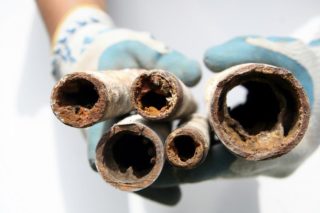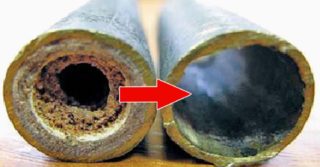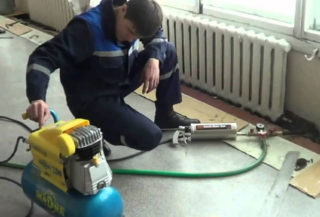Typically, heating systems contain pipes and water. Time spares nothing, and as a result, pipes under the influence of water begin to rust. Rusty places fall off, and under the influence of the pressure of water, spalls are carried through the pipes until they are stopped by a bend or something else. But in plastic pipes this is not, but there are problems here: when the water is heated, a limestone layer and something like sediment are formed on the walls of the pipes. With strong heating, water evaporates quickly, so it must be added continuously. This, in turn, only accelerates the onset of sedimentary processes.
The main causes of pipe clogging are also the smallest organisms with their waste products, which have every chance of flourishing in such systems, especially during the period of heating shutdown. Their presence is indicated by the formation of a dark sediment at the base of the pipe, which, in turn, can be considered a source of clogging.
Consequences of clogging
- after a certain moment, the pipes are clogged;
- the movement of water in the pipes is reduced and later even the water pump will not be able to pump water through this system.
Things are much worse with thermosyphon heating, where there is no such pump. As a rule, after clogging, heat is not allowed through and the pipes remain cold. And this is only part of the trouble. In addition, the boiler itself begins to heat up strongly, which can lead to its breakdown.
Some owners carry out an annual cleanup of the blockages of such a system by changing the water. In other words, the old unclean, rusty water is drained and filled with new. And this is reasonable, because when the old water is drained, a small amount of chips and rust leaves it. But there is also an opposite side. Iron and oxygen are needed for rust to appear. If the pipe is metal, then iron is always present in it, but oxygen is contained in the water. As a rule, when you do not change the liquid in the heating system for a long time, the oxygen content in it decreases significantly, which means that the rusting process stops. With a constant change of water, on the contrary, its activation occurs. Summing up a small summary, we can say one thing - this method helps to get rid of a small amount of rust, but, on the other hand, we only speed up the new process of its formation.
Rust control
The entire cleaning stage is relatively simple and does not require complex techniques. The process will proceed as follows:
- pipe cleaning;
- cleaning the heating boiler itself.
Pipe cleaning
Ordinary citric acid, which every housewife has, can act as such a remedy.It must be dissolved in water, it is advisable to use a three-liter jar, since a large amount gives a greater effect. All this solution must be poured into the heating system. Subsequently, it is immediately necessary to light the boiler, set the temperature to a high mark, and it remains to wait twenty-four hours. Later we drain this water. We wash the pipes by filling and re-draining clean water.
Another similar technique is the use of food vinegar. To achieve the best effect, you need a lot of it. But there is also a more safe option - the use of hydrochloric acid, mainly 10 or 20%. This chemical is excellent for cleaning pipes. But you need to be careful with this substance, as too high a concentration can significantly damage the heating system.
The process will proceed as follows:
- we connect the compressor to the heating system;
- we connect the compressor to the pipe and start;
- flushing begins with a simultaneous combination with pneumatic blows;
- disconnect the pipe going to the boiler (bottom);
- we put some container next to it so that dirty water flows there;
- clean water must constantly flow into the riser (during the discharge of unclean water).
The compressor is expensive and if you don't want to spend money, then you can dismantle the radiators (each separately). That is, they are flushed under tremendous water pressure.
Boiler cleaning
There may be deposits in the boiler itself. In addition, there are more of them here than in pipes. The fact is that it heats up very much, due to which the process is accelerated.
Chemicals are used here. The whole work is quite simple: you need to disconnect the heating pipes, take a pump that is combined with a boiler and water is admitted through it, with chemistry added in advance. We drain all the dirty water and then rinse it with clean water.
Having mastered all the considered tips, you will be able to flush the heating system with full confidence on your own.











